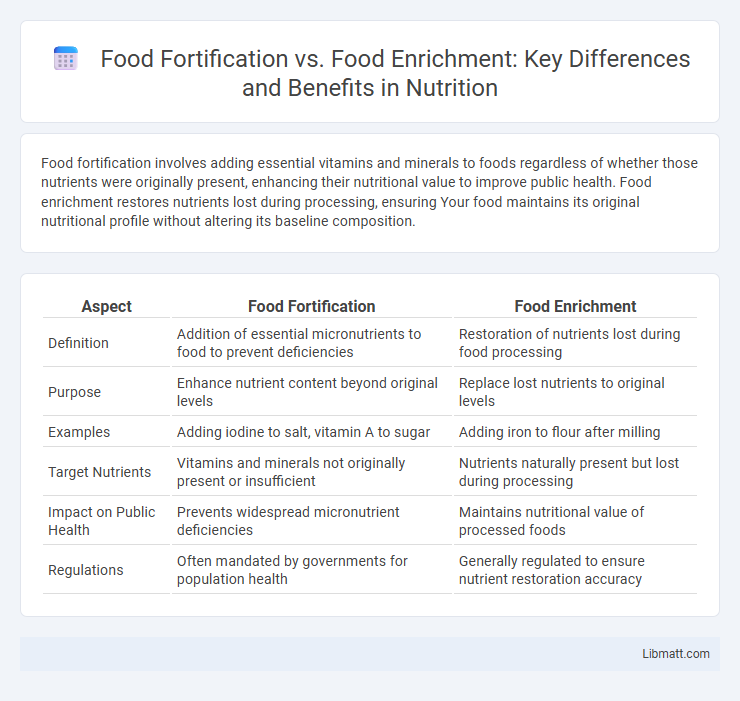Food fortification involves adding essential vitamins and minerals to foods regardless of whether those nutrients were originally present, enhancing their nutritional value to improve public health. Food enrichment restores nutrients lost during processing, ensuring Your food maintains its original nutritional profile without altering its baseline composition.
Table of Comparison
| Aspect | Food Fortification | Food Enrichment |
|---|---|---|
| Definition | Addition of essential micronutrients to food to prevent deficiencies | Restoration of nutrients lost during food processing |
| Purpose | Enhance nutrient content beyond original levels | Replace lost nutrients to original levels |
| Examples | Adding iodine to salt, vitamin A to sugar | Adding iron to flour after milling |
| Target Nutrients | Vitamins and minerals not originally present or insufficient | Nutrients naturally present but lost during processing |
| Impact on Public Health | Prevents widespread micronutrient deficiencies | Maintains nutritional value of processed foods |
| Regulations | Often mandated by governments for population health | Generally regulated to ensure nutrient restoration accuracy |
Introduction to Food Fortification and Food Enrichment
Food fortification involves adding essential vitamins and minerals to staple foods to prevent nutrient deficiencies in the population, while food enrichment restores nutrients lost during food processing. Fortification targets public health by enhancing the nutritional profile of commonly consumed foods, such as adding iodine to salt or vitamin D to milk. Understanding these processes helps you make informed dietary choices that support overall health and prevent malnutrition.
Defining Food Fortification
Food fortification involves deliberately adding essential vitamins and minerals to staple foods to prevent nutrient deficiencies in a population. Unlike food enrichment, which replaces nutrients lost during processing, fortification enhances the nutritional value beyond the original content. Understanding your role in choosing fortified foods helps address specific dietary gaps and supports overall health.
Understanding Food Enrichment
Food enrichment involves restoring essential nutrients lost during food processing to their original levels, ensuring the nutritional value is maintained. This process primarily targets vitamins and minerals such as iron, B vitamins, and folic acid, which are critical for preventing deficiencies. Unlike fortification, enrichment does not add nutrients beyond what naturally exists in the food but rather replaces those removed during refinement.
Key Differences Between Fortification and Enrichment
Food fortification involves adding nutrients that were not originally present in the food to enhance its nutritional value, such as adding vitamin D to milk. Food enrichment restores nutrients lost during food processing to their original levels, like replacing iron removed during the milling of wheat. The key difference lies in fortification introducing new nutrients beyond the natural content, whereas enrichment compensates for nutrient losses during processing.
Commonly Fortified Foods
Commonly fortified foods include breakfast cereals, milk, and salt, which are enriched with essential nutrients like vitamins A, D, and iodine to prevent widespread deficiencies. Fortification targets basic staple foods consumed regularly to improve public health on a large scale, while enrichment typically restores nutrients lost during processing in products like white flour and rice. Your diet benefits most when these fortified foods consistently supply critical nutrients that support overall wellness and prevent malnutrition.
Popular Enriched Foods
Popular enriched foods include white bread, pasta, and cereal, which have essential nutrients like iron, B vitamins, and folic acid restored after processing. Food enrichment compensates for nutrient loss, ensuring your diet contains key vitamins and minerals. Unlike food fortification, enrichment specifically restores nutrients lost during food refining.
Health Benefits of Food Fortification
Food fortification enhances the nutritional quality of food by adding essential vitamins and minerals, helping to prevent nutrient deficiencies and related health issues such as anemia, rickets, and neural tube defects. Unlike food enrichment, which restores nutrients lost during processing, fortification introduces additional nutrients that may not naturally be present, significantly improving public health outcomes. Your diet benefits from fortified foods by supporting immune function, cognitive development, and overall wellness, especially in vulnerable populations.
Nutritional Impact of Food Enrichment
Food enrichment involves adding essential nutrients lost during food processing back to their original levels, significantly improving the nutritional value without altering the food's natural state. This process enhances Your dietary intake by restoring vital vitamins and minerals, such as iron, folic acid, and B vitamins, which are crucial for preventing deficiencies and supporting overall health. Enriched foods help address nutrient gaps in populations, thereby reducing the risk of anemia, neural tube defects, and other nutrition-related disorders.
Regulatory Guidelines for Fortification and Enrichment
Regulatory guidelines for food fortification and enrichment establish specific nutrient levels to ensure safety and efficacy, with agencies like the FDA and WHO providing frameworks for mandatory and voluntary programs. Food fortification typically involves adding micronutrients to staple foods to prevent public health deficiencies, whereas enrichment restores nutrients lost during processing, both requiring compliance with regional standards and labeling requirements. Your compliance with these regulations ensures product safety, consumer trust, and alignment with nutritional policies aimed at combating malnutrition.
Challenges and Future Trends in Food Fortification and Enrichment
Challenges in food fortification and enrichment include maintaining nutrient stability during processing, bioavailability, and consumer acceptance. Future trends emphasize personalized nutrition, advanced encapsulation technologies, and sustainable sourcing to enhance nutrient retention and targeted health benefits. Your ability to navigate these innovations will shape the effectiveness of fortified and enriched foods in addressing global malnutrition.
food fortification vs food enrichment Infographic

 libmatt.com
libmatt.com